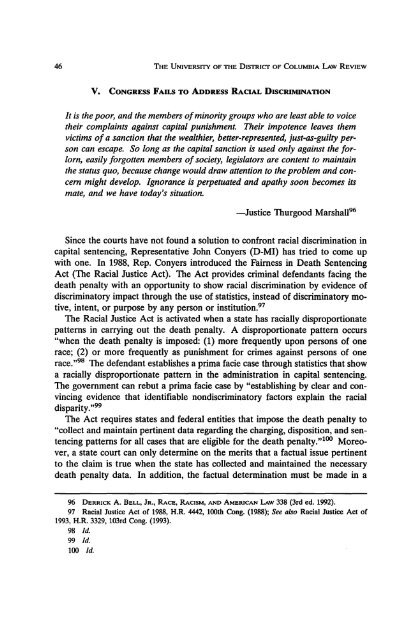The University of the District of Columbia Law ... - UDC Law Review
The University of the District of Columbia Law ... - UDC Law Review
The University of the District of Columbia Law ... - UDC Law Review
You also want an ePaper? Increase the reach of your titles
YUMPU automatically turns print PDFs into web optimized ePapers that Google loves.
46 THE UNIVERSITY OF THE DISTRlcr OF COLUMBIA LAW REVIEWv. CONGRESS FAILS TO AnDRESS RACIAL DISCRIMINATIONIt is <strong>the</strong> poor, and <strong>the</strong> members <strong>of</strong> minority groups who are least able to voice<strong>the</strong>ir complaints against capital punishment. <strong>The</strong>ir impotence leaves <strong>the</strong>mvictims <strong>of</strong> a sanction that <strong>the</strong> wealthier, better-represented, just-as-guilty personcan escape. So long as <strong>the</strong> capital sanction is used only against <strong>the</strong> forlorn,easily forgotten members <strong>of</strong> society, legislators are content to maintain<strong>the</strong> status quo, because change would draw attention to <strong>the</strong> problem and concernmight develop. Ignorance is perpetuated and apathy soon becomes itsmate, and we have today's situation.-Justice Thurgood Marsha1l 96Since <strong>the</strong> courts have not found a solution to confront racial discrimination incapital sentencing, Representative John Conyers (D-MI) has tried to come upwith one. In 1988, Rep. Conyers introduced <strong>the</strong> Fairness in Death SentencingAct (<strong>The</strong> Racial Justice Act). <strong>The</strong> Act provides criminal defendants facing <strong>the</strong>death penalty with an opportunity to show racial discrimination by evidence <strong>of</strong>discriminatory impact through <strong>the</strong> use <strong>of</strong> statistics, instead <strong>of</strong> discriminatory motive,intent, or purpose by any person or institution. 97<strong>The</strong> Racial Justice Act is activated when a state has racially disproportionatepatterns in carrying out <strong>the</strong> death penalty. A disproportionate pattern occurs"when <strong>the</strong> death penalty is imposed: (1) more frequently upon persons <strong>of</strong> onerace; (2) or more frequently as punishment for crimes against persons <strong>of</strong> onerace.,,98 <strong>The</strong> defendant establishes a prima facie case through statistics that showa racially disproportionate pattern in <strong>the</strong> administration in capital sentencing.<strong>The</strong> government can rebut a prima facie case by "establishing by clear and convincingevidence that identifiable nondiscriminatory factors explain <strong>the</strong> racialdisparity. ,,99<strong>The</strong> Act requires states and federal entities that impose <strong>the</strong> death penalty to"collect and maintain pertinent data regarding <strong>the</strong> charging, disposition, and sentencingpatterns for all cases that are eligible for <strong>the</strong> death penalty."lOO Moreover,a state court can only determine on <strong>the</strong> merits that a factual issue pertinentto <strong>the</strong> claim is true when <strong>the</strong> state has collected and maintained <strong>the</strong> necessarydeath penalty data. In addition, <strong>the</strong> factual determination must be made in a96 DERRICK A. BELL, JR., RACE, RACISM, AND AMERICAN LAW 338 (3rd ed. 1992).97 Racial Justice Act <strong>of</strong> 1988, H.R. 4442, 100th Cong. (1988); See also Racial Justice Act <strong>of</strong>1993, H.R. 3329, 103rd Congo (1993).98 Id.99 Id.100 Id.














